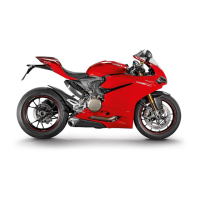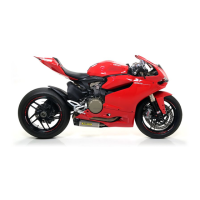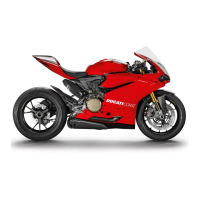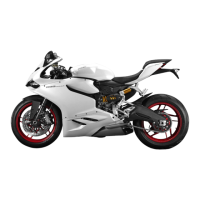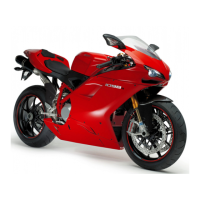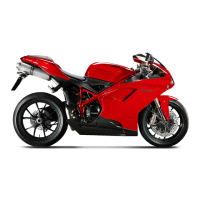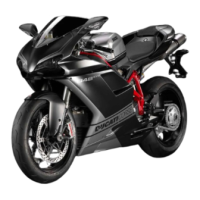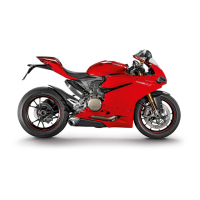
Do you have a question about the Ducati Superbike 1299 Panigale S 2016 and is the answer not in the manual?
| Displacement | 1285 cc |
|---|---|
| Torque | 106.7 lb-ft (144.6 Nm) @ 8, 750 rpm |
| Transmission | 6-speed |
| Frame | Monocoque aluminum |
| Engine Type | L-twin, 4 valves per cylinder, liquid-cooled |
| Power | 205 hp |
| Seat Height | 830 mm |
| Fuel Capacity | 17 liters |
| Front Suspension | Öhlins NIX30, fully adjustable |
| Rear Suspension | Ohlins TTX36 fully adjustable shock |
| Front Brake | 2 x 330mm semi-floating discs, radially mounted Brembo Monobloc M50 4-piston calipers |
| Rear Brake | 245 mm disc, 2-piston caliper |
| ABS | Bosch Cornering ABS |
| Traction Control | Ducati Traction Control (DTC) |
| Wheelbase | 1430 mm |
| Electronics | Ducati Quick Shift (DQS) up/down |
| Tires | Pirelli Diablo Supercorsa SP |
Guidelines for safe and enjoyable riding, emphasizing quality standards and genuine parts.
Specifies that the motorcycle is for asphalted roads only, not for off-road use.
Details requirements for riders, including valid license, insurance, and helmet use.
Importance of proper riding gear including helmet, gloves, jacket, and boots for rider safety.
Information on hazards associated with used engine oil, brake fluid, and coolant.
Description of the instrument panel layout and indicator lights.
Explains the meaning of the ABS indicator light status.
Details the status indications for DTC and DWC warning lights.
List of acronyms and abbreviations used in the manual.
Explanation of the three preset motorcycle configurations (Riding Modes).
Details the Ducati Traction Control system and its intervention levels.
Description of the ABS system, its functions, and intervention levels.
Explanation of the Ducati Quick Shift system for gear changes.
Information on the Ducati Wheelie Control system.
Details the function and operation of the handlebar push-buttons.
Instructions on how to set and display parameters on the instrument panel.
Description of the two available main screen layouts: ROAD and TRACK.
Lists the main functions displayed on the standard screen.
Details the various functions available within the Setting MENU.
Instructions on how to navigate and enter the Setting MENU.
Explanation of how motorcycle speed is displayed and its calculation.
Describes how the engaged gear is displayed and shift gear indications.
How to select and display the available Riding Modes (Race, Sport, Wet).
General overview of how to customize settings for each riding mode.
Procedure to disable or set the DTC level for each riding mode.
Function to disable or set the ABS level for the selected riding mode.
Allows selection of compression and rebound settings for electronic suspension.
Allows the rider to select the main screen layout for each riding mode.
Function to disable or enable the DQS for the selected riding mode.
Customizes engine power associated with each riding mode.
Disables or sets the rear wheel antilocking system (EBC) level.
Disables or sets the DWC level for the selected riding mode.
Restores default values set by Ducati for parameters related to each riding mode.
Associates functions with UP/DOWN buttons on the auxiliary switch.
Displays the engine RPM in digital format for improved accuracy.
Allows checking the motorcycle battery voltage status.
Enables, disables, and views DDA memory usage.
Instructions for viewing and deleting stored DDA memory.
Function to temporarily enable motorcycle operation if E-Lock is faulty.
Procedure to activate the PIN CODE function and enter the user's PIN.
Instructions for changing the existing PIN CODE.
Function to set or adjust the motorcycle's time.
Procedure for setting the hour value for the clock.
Procedure for setting the minute value for the clock.
Procedure for setting the AM/PM indicator for the clock.
Function to set or adjust the motorcycle's date.
Procedure for setting the year value for the date.
Procedure for setting the month value for the date.
Procedure for setting the day value for the date.
Allows selection of the instrument panel backlighting mode (Day, Night, Auto).
Information on viewing stored LAP data: time, speed, RPM, lean angle.
Instructions for viewing stored laps and their data.
Procedure for deleting all stored LAP data.
Allows changing units for speed, temperature, and fuel consumption.
Procedure to change units of measurement for speed and distance.
Procedure to change units of measurement for fuel consumption.
Restores automatic settings for units of measurement on the instrument panel.
Allows recalibration of the system for new tyres or sprocket ratio.
Steps for the calibration procedure of rolling circumference and final drive ratio.
Restores the factory default settings for the Tyre Set-Up menu.
Manages headlight switching to reduce current consumption.
Activates parking lights when the motorcycle is turned off.
Turns on all four turn indicators to signal an emergency condition.
Electronic system inhibiting engine operation without recognized ignition key.
Information on the two provided keys and their functions.
Procedure to restore motorcycle operation using PIN code during malfunction.
Shows the position and function of controls for riding the motorcycle.
Details the ignition switch positions: ON, OFF, and LOCK.
Description of the left and right handlebar switch functions.
Explanation of clutch lever, throttle, front brake, rear brake, and gear pedal.
Instructions for adjusting the gearchange and rear brake pedal positions.
Identifies major motorcycle components and their locations.
Instructions for opening and closing the fuel tank filler plug.
Procedure for opening and closing the seat lock.
Instructions on using and checking the side stand.
Information on the steering damper and its adjustment.
Details on adjusting the front fork's rebound, compression, and preload.
Instructions for adjusting the rear shock absorber preload and damping.
Guidance on adjusting motorcycle track alignment.
Guidelines for engine, brake, and suspension break-in for longer life.
Essential checks to perform before riding for safety and damage prevention.
Procedure for safely starting the motorcycle engine.
Step-by-step guide for starting to move the motorcycle.
Techniques for effective braking, including engine braking and ABS use.
Procedure for safely stopping and parking the motorcycle.
Instructions and warnings for refueling the motorcycle.
Instructions on removing fairing parts for maintenance.
Details on removing side fairings using the Allen wrench.
Recommendation to have air filter maintenance performed by a dealer.
Procedure for checking and topping up the coolant level.
Instructions for checking brake and clutch fluid levels.
Procedure for checking brake pad wear through inspection holes.
Step-by-step guide on how to remove and charge the motorcycle battery.
Recommendations for battery maintenance during winter storage.
Instructions for checking and adjusting drive chain tension.
Guidance on cleaning and lubricating the O-ring chain.
Information on replacing high/low beam bulbs and parking lights.
Procedure for checking and adjusting headlight aim.
Instructions on how to manually adjust the rear-view mirrors.
Details on front and rear tyre pressures and maintenance.
Guidance on measuring minimum tread depth and inspecting tyres.
Procedure for checking engine oil level via sight glass.
Importance of checking and replacing spark plugs for smooth running.
Instructions for washing and cleaning the motorcycle to preserve finish.
Recommended operations before storing the motorcycle for long periods.
Scheduled maintenance operations to be performed by authorized dealers.
Scheduled maintenance operations to be performed by the owner.
Provides overall weight and dimensions of the motorcycle.
Details required fluids, lubricants, and their capacities for top-ups.
Technical data regarding the engine, including bore, stroke, and displacement.
Covers performance figures, spark plugs, fuel system, and brake specifications.
Details on the transmission, clutch, gear ratios, and drive chain.
Specifications for frame, wheels, tyres, and suspension systems.
Information on the motorcycle's electrical components and system.
Details on the location and ratings of fuses protecting electrical components.
Key for understanding the injection and electric system wiring diagram.
A logbook for recording routine Ducati service appointments.
